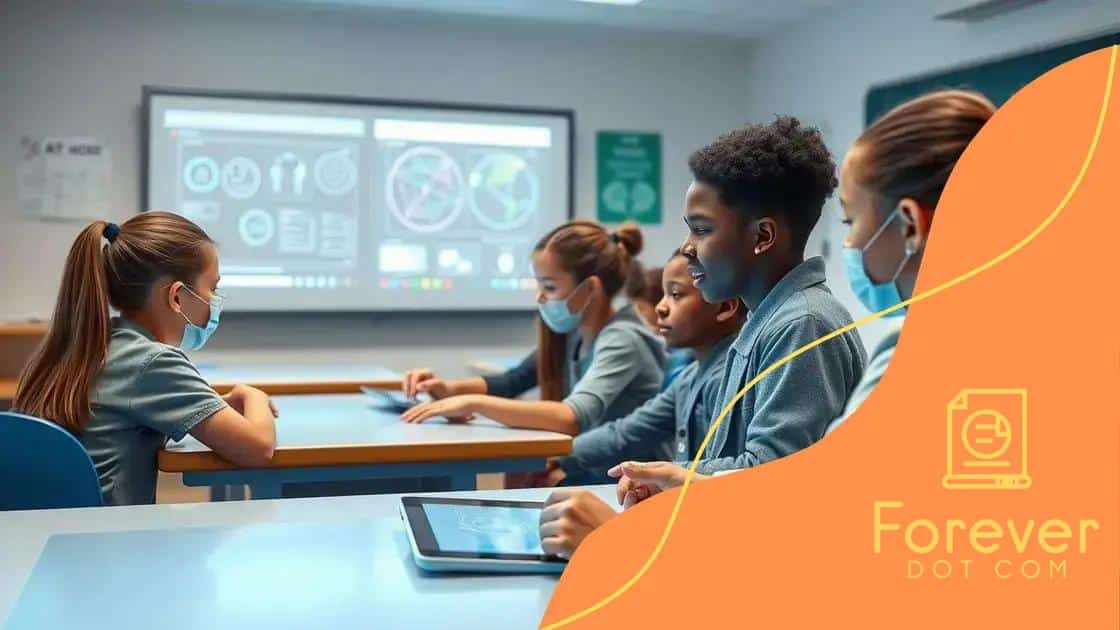How to integrate AI into university teaching methods

Integrating AI into university teaching methods enhances personalized learning, streamlines administrative tasks, and prepares students for a technology-driven future, addressing both engagement and efficiency.
How to integrate AI into university teaching methods could shape the future of education remarkably. Imagine classrooms where personalized learning is the norm and administrative tasks are automated. Intrigued? Let’s explore how this technology can enhance learning experiences.
Understanding AI in education
Understanding AI in education is crucial for modern learning environments. As technology advances, schools and universities are exploring ways to incorporate artificial intelligence into their teaching methods. This integration can improve student outcomes and streamline administrative tasks.
What is AI?
AI refers to computer systems designed to mimic human intelligence. This includes learning, reasoning, and problem-solving abilities. In education, AI can offer personalized learning experiences for students. By analyzing data on student performance, AI can tailor lessons to fit individual needs.
Benefits of AI in Education
There are several benefits of implementing AI in education, including:
- Personalized learning: AI can adapt resources to meet each student’s needs.
- Efficient grading: AI can assist educators by grading assignments faster.
- Predictive analytics: AI can identify at-risk students based on performance data.
Using AI helps educators focus on teaching instead of administrative tasks, fostering a better learning environment. Engagement is another area where AI shines. For instance, interactive tools powered by AI can make learning more appealing, sparking student interest.
Real-world Examples of AI in Education
Some schools are already using AI effectively. Personalized learning software adjusts content based on each student’s learning pace. Virtual tutors powered by AI can provide additional support to students outside classroom hours. By incorporating these tools, educators can enhance the overall learning experience.
In summary, understanding AI in education allows institutions to leverage technology for enhanced learning. As AI evolves, its role will likely expand, making it essential for educators to stay informed.
Benefits of AI for teaching
The benefits of AI for teaching are transforming the educational landscape. Incorporating artificial intelligence in classrooms leads to personalized learning, making education more accessible and effective. With AI, teachers can cater to each student’s unique learning style and pace.
Key Advantages of AI in Teaching
There are several significant benefits of using AI in the teaching process:
- Enhanced engagement: Interactive AI tools can keep students engaged and motivated.
- Time-saving: AI can automate administrative tasks, freeing educators to focus on teaching.
- Data-driven insights: AI provides teachers with insights into student performance, helping them make informed decisions.
Additionally, AI for teaching opens doors for innovative approaches to learning. For example, virtual reality experiences can immerse students in their subjects. This method can make complex topics more relatable and understandable.
Personalized Learning Experience
One of the most impressive benefits of AI is its ability to create tailored learning experiences. Students can learn at their own pace with adaptive learning platforms, which adjust the content to match their progress. This personalization helps students master concepts without feeling overwhelmed.
The combination of AI and process automation results in a more efficient teaching environment. Teachers can address challenges in real time, adapting their methods to fit the needs of their classrooms. This responsive framework leads to better student outcomes and satisfaction.
Support Beyond the Classroom
Moreover, AI for teaching extends its benefits beyond traditional classroom settings. For instance, AI tutors and educational apps can provide support outside school hours. Such resources offer students additional help whenever they need it. Hence, learning becomes a more flexible and continuous process.
Incorporating AI in education not only supports teachers but enriches the entire learning experience for students. The potential to improve teaching effectiveness while enhancing student engagement is a substantial leap forward in the realm of education.
Practical examples of AI integration

Practical examples of AI integration in education show how technology can enhance learning experiences. Many schools and universities are adopting AI tools to improve teaching methods and student engagement. These examples highlight the versatility and effectiveness of AI in real-world educational settings.
AI-Powered Tutoring Systems
One excellent example of AI integration is the use of AI-powered tutoring systems. These systems provide personalized assistance to students by adapting to their individual learning rates. For instance, platforms like Khan Academy and Duolingo use algorithms to analyze student performance and tailor the learning experience accordingly.
Automated Administrative Tasks
AI simplifies many administrative tasks in schools. Tools like GradeScope automate grading processes, allowing teachers to focus more on classroom interactions. AI systems can also manage scheduling and track student attendance, reducing workloads for staff.
- Chatbots assist with answering student inquiries and providing information.
- Learning analytics can identify trends to help educators make data-driven decisions.
- Virtual learning environments can foster collaboration between students from different locations.
Moreover, some universities are employing virtual reality (VR) to create immersive learning experiences. For example, medical students can practice procedures in simulated environments powered by AI. This hands-on approach enhances understanding and retention of complex concepts.
Personalized Learning Platforms
Then, there are personalized learning platforms like Smart Sparrow that adapt the curriculum based on real-time performance data. This tailored approach allows students to learn at their own pace, ensuring a deeper understanding of the material. Such platforms often incorporate gamification techniques to make learning more engaging.
Incorporating these practical examples of AI integration not only improves the educational experience but also prepares students for a future where technology plays a crucial role. The use of AI in classrooms continues to grow, providing valuable tools for both students and educators alike.
Challenges of implementing AI
Implementing AI in education brings exciting opportunities, but it also comes with significant challenges. Understanding these challenges is crucial for educators and institutions that wish to adopt AI solutions.
Cost and Resources
One major challenge is the cost associated with integrating AI technology. Schools may struggle with the expenses of purchasing software and hardware. Additionally, maintaining these systems requires ongoing funds.
Training Educators
Another challenge lies in training educators to use AI tools effectively. Not all teachers are familiar with technology or comfortable using new systems. Providing comprehensive training programs is essential, yet time-consuming and requires resources.
- Workshops can help educators understand how AI works.
- Ongoing support ensures that teachers can adapt.
- Peer mentorship programs can facilitate knowledge sharing among staff.
Moreover, there’s often resistance to change. Some educators might be skeptical about relying on technology in the classroom. Addressing these concerns is vital to encourage acceptance. Communicating the benefits of AI integration can help alleviate worries and foster a positive outlook.
Data Privacy and Security
Data privacy issues also present a significant hurdle. Schools must ensure that student information is protected while using AI systems. This includes understanding data regulations and potential risks associated with data breaches. Schools need to invest in cybersecurity measures to protect sensitive information.
Additionally, not all AI tools are created equally. The effectiveness of some systems can vary, leading to uneven results. Evaluating various AI solutions becomes crucial for educators to determine what best fits their needs.
Overall, while the challenges of implementing AI in education are real, they can be overcome with proper planning, support, and resources. By addressing costs, training needs, resistance to change, and data security, schools can successfully integrate AI technologies.
Future of AI in university education
The future of AI in university education looks promising and exciting. As technology evolves, universities are increasingly integrating AI to enhance the learning experience and improve administrative processes. This shift offers many opportunities for students and educators alike.
Enhanced Learning Experiences
One significant aspect of the future is the use of AI to create more interactive and personalized learning environments. Students will benefit from tailored educational content that adapts to their unique learning styles and needs. As AI algorithms become more sophisticated, they can predict the best teaching methods for each individual.
Virtual Reality and Augmented Reality
Another exciting development is the integration of AI with virtual and augmented reality (VR/AR). These technologies can immerse students in real-world scenarios, enhancing their understanding of complex subjects. For example, medical students could practice surgeries in a simulated environment, providing invaluable hands-on experience.
- Students can engage in interactive simulations that make learning more engaging.
- Collaboration tools powered by AI can connect students globally.
- AI can help in designing adaptive assessments that reflect student progress accurately.
Furthermore, AI in university education can streamline administrative tasks, such as enrollment and scheduling. Automation will allow staff to focus on more critical duties, ultimately improving the overall effectiveness of the institution. This efficiency enables universities to allocate more resources towards enhancing student support services.
Predictive Analytics for Student Success
Additionally, predictive analytics will play a crucial role in identifying at-risk students. By analyzing data, AI systems can provide early warnings, allowing educators to intervene and support students who may struggle. This proactive approach can enhance retention rates and promote academic success.
As we look ahead, the inclusion of AI in university education presents many opportunities for innovation and improvement. With ongoing advancements, AI will undoubtedly redefine the educational landscape, making learning more personalized, engaging, and effective.
FAQ – Frequently Asked Questions about AI in University Education
What are the primary benefits of integrating AI in university education?
The primary benefits include personalized learning experiences, streamlined administrative tasks, and improved data utilization for making informed decisions.
What challenges do universities face when implementing AI?
Challenges include the cost of technology, the need for training educators, data privacy concerns, and addressing resistance to change.
How can predictive analytics help students in universities?
Predictive analytics can identify at-risk students early, allowing educators to provide support and improve retention rates.
What future opportunities does AI present for university students?
AI presents opportunities for immersive learning experiences, real-time feedback, and preparation for a technology-driven workforce.






